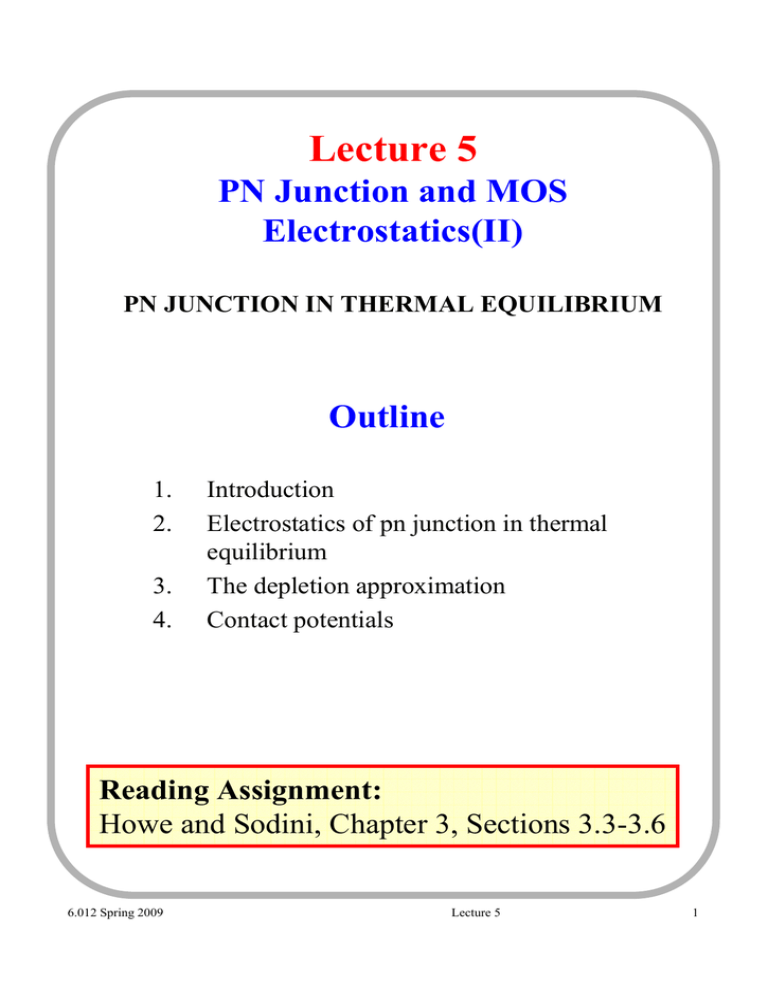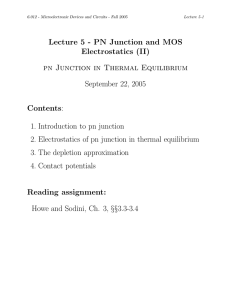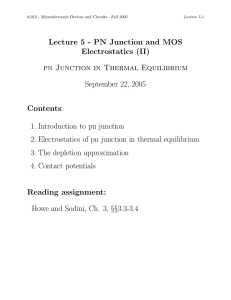Document 13436424
advertisement

Lecture 5 PN Junction and MOS Electrostatics(II) PN JUNCTION IN THERMAL EQUILIBRIUM Outline 1. 2. 3. 4. Introduction Electrostatics of pn junction in thermal equilibrium The depletion approximation Contact potentials Reading Assignment: Howe and Sodini, Chapter 3, Sections 3.3­3.6 6.012 Spring 2009 Lecture 5 1 1. Introduction • pn junction – p­region and n­region in intimate contact Why is the p­n junction worth studying? It is present in virtually every semiconductor device! Example: CMOS cross­section p-MOSFET n+ p+ n-MOSFET p+ n n+ n+ p+ p Figure by MIT OpenCourseWare. Understanding the pn junction is essential to understanding transistor operation 6.012 Spring 2009 Lecture 5 2 2. Electrostatics of p­n junction in equilibrium Focus on intrinsic region: Doping distribution of an abrupt p­n junction 6.012 Spring 2009 Lecture 5 3 What is the carrier concentration distribution in thermal equilibrium? First think of the two sides separately: Now bring the two sides together. What happens? 6.012 Spring 2009 Lecture 5 4 Resulting carrier concentration profile in thermal equilibrium: • Far away from the metallurgical junction: nothing happens – Two quasi­neutral regions • Around the metallurgical junction: diffusion of carriers must counter­balance drift – Space­charge region 6.012 Spring 2009 Lecture 5 5 On a linear scale: Thermal equilibrium: balance between drift and diffusion J n (x) = J ndrift (x) + J ndiff (x) = 0 J p (x) = J pdrift (x) + J pdiff (x) = 0 We can divide semiconductor into three regions • Two quasi­neutral n­ and p­regions (QNR’s) • One space­charge region (SCR) Now, we want to know no(x), po(x), ρ(x), E(x) and φ(x). We need to solve Poisson’s equation using a simple but powerful approximation 6.012 Spring 2009 Lecture 5 6 3. The Depletion Approximation • Assume the QNR’s are perfectly charge neutral • Assume the SCR is depleted of carriers – depletion region • Transition between SCR and QNR’s sharp at – ­xpo and xno (must calculate where to place these) x < −x po ; ni2 po (x) = N a , no (x) = Na −x po < x < 0; po (x), no (x) << N a 0 < x < xno ; no (x), x > xno ; 6.012 Spring 2009 po (x) << N d no (x) = N d , ni2 po (x) = Nd Lecture 5 7 Space Charge Density ρ(x) = 0; = − qN a ; −x po < x < 0 = 0 < x < xno x > x no = 0; 6.012 Spring 2009 x < −x po qNd ; Lecture 5 8 Electric Field Integrate Poisson’s equation E(x2 ) − E(x1 ) = 1 x2 ρ(x) dx ∫ εs x 1 x < − x po ; − x po < x < 0; E(x) = 0 E(x) − E( −x po ) = x 1 εs − x∫ po −qN a dx ′ qN a x − qN a = − x = x + x po ε ε −x s s po ( qN d 0 < x < xno ; E(x) = x > xno ; E(x) = 0 6.012 Spring 2009 εs ) (x − xno ) Lecture 5 9 Electrostatic Potential (with φ=0 @ no=po=ni) φ= kT n • ln o q ni φ=− kT p • ln o q ni In QNRs, no and po are known ⇒ can determine φ in p­QNR: po=Na ⇒ φp = − N kT • ln a q ni kT Nd φ = • ln in n­QNR: no=Nd ⇒ n q ni Built­in potential: Nd Na kT φ B = φn − φ p = • ln q ni2 This expression is always correct in TE! We did not use depletion approximation. 6.012 Spring 2009 Lecture 5 10 To obtain φ(x) in between, integrate E(x) x2 φ(x2 ) − φ(x1) = − ∫ E(x′)dx′ x1 x < −x po ; −x po < x < 0; φ(x) = φp x φ(x) − φ(−x po ) = − ∫ − qNa −x po ( εs (x ′ + x po )dx ′ ) 2 qNa x + x po 2ε s 2 qN φ(x) = φ p + a x + x po 2ε s = ( 0 < x < xno ; φ(x) = φn − ) qNd 2 x − xno ) ( 2ε s φ (x) = φn Almost done …. x > xno ; 6.012 Spring 2009 Lecture 5 11 Still do not know xno and xpo ⇒ need two more equations 1. Require overall charge neutrality: qN a x po = qN d x no 2. Require φ(x) to be continuous at x=0; φp + qN a 2 qN d 2 x po = φ n − x no 2εε s 2εε s Two equations with two unknowns — obtain solution: 2εε s φ B N a x no = q(N a + N d )N d 2εε s φ B N d x po = q(N a + N d )N a Now problem is completely solved! 6.012 Spring 2009 Lecture 5 12 Solution Summary Space Charge Density Electrostatic Field Electrostatic Potential 6.012 Spring 2009 Lecture 5 13 Other results: Width of the space charge region: x do = x po + x no = 2εε s φ B (N a + N d ) qN a N d Field at the metallurgical junction: 2qφ φB Na Nd Eo = ε s (N a + N d ) 6.012 Spring 2009 Lecture 5 14 Three Special Cases • Symmetric junction: Na = Nd x po = x no • Asymmetric junction: Na > Nd x po < x no • Strongly asymmetric junction – p+n junction: Na >> Nd 2 εs φB x po << xno ≈ x do ≈ qNd Eo ≈ 2qφ B Nd εs The lightly­doped side controls the electrostatics of the pn junction 6.012 Spring 2009 Lecture 5 15 4. Contact Potential Potential distribution in thermal equilibrium so far: Question 1: If I apply a voltmeter across the pn junction diode, do I measure φB? yes no it depends Question 2: If I short terminals of pn junction diode, does current flow on the outside circuit? yes 6.012 Spring 2009 no sometimes Lecture 5 16 We are missing contact potential at the metal­ semiconductor contacts: Metal­semiconductor contacts: junction of dissimilar materials ⇒ built­in potentials at contacts φmn and φmp. Potential difference across structure must be zero ⇒ Cannot measure φB. φ B = φmn + φmp 6.012 Spring 2009 Lecture 5 17 5. PN Junction-Reverse Bias Assume: No Current Flows - - t + ZDsOA + O v, (<OW ohmic contact to %wn p side -w,~///////////A - -PI - ++j X - %I qmn + - (a> t+'"' Same Analysis applies: (b) Substitute 6.012Spring 2009 Lecture B ohmic contact to n side What did we learn today? Summary of Key Concepts • Electrostatics of pn junction in equilibrium – A space­charge region surrounded by two quasi­neutral regions formed. • To first order, carrier concentrations in space­charge region are much smaller than the doping level – ⇒ can use Depletion Approximation • From contact to contact, there is no potential build­ up across the pn junction diode – Contact potential(s). 6.012 Spring 2009 Lecture 5 19 MIT OpenCourseWare http://ocw.mit.edu 6.012 Microelectronic Devices and Circuits Spring 2009 For information about citing these materials or our Terms of Use, visit: http://ocw.mit.edu/terms.







